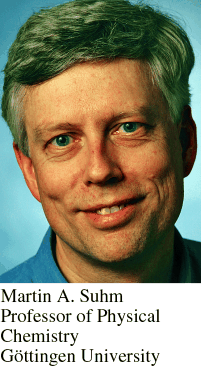Guinness Molecules: Identifying Lowest-Energy Structures
Abstract
“ Which is the most stable molecular structure of the sum formula C6H12O6? Nobody really knows yet, but for sure it is not glucose. The winners—and there is just one for every reasonable sum formula—might be termed ‘Guinness molecules ’ Read more in the Editorial by Martin Suhm.
Every interested child knows the highest mountain on earth—Mount Everest—and many also know the deepest trough—the Mariana Trench. On geological time scales, these natural maxima and minima on the two-dimensional surface of the Earth are not particularly stable—so what about timeless molecular analogues? Which is the most stable molecular structure of the sum formula C6H12O6? Nobody really knows yet, but for sure it is not glucose. The quest for the lowest-energy structure with a given atomic composition is neither part of the informative Wiley-VCH book World Records in Chemistry, nor of other popular compendia of records. The winners—and there is just one for every reasonable sum formula—might nevertheless be termed “Guinness molecules”. While such Guinness molecules may appear slightly more boring than their high-energy counterparts, they are similarly important in the topical field of chemical energy conversion. Of course, one should define things precisely in chemistry and a meaningful reference point is the isolated molecule or molecular assembly at very low temperature, where environmental or packing effects and entropy do not come into play as game spoilers. Also, synthetic chemists should probably not allow for nuclear fusion processes to occur along with isomerization.1

Straightforward Answers?
There are a number of cases where the answer is straightforward. Nobody would challenge the water molecule to be the most stable compound with the formula H2O. Even for H10O5 , there is a consensus that it is some kind of floppy hydrogen-bonded ring structure realized by five water units. For H12O6 , most researchers would agree that the case has now been settled for a cage structure, but only in very close competition with other supramolecular arrangements. This is definitely a case in which one should make sure that the temperature is low enough and zero-point motion of the nuclei has been included. (CO2)n is another example for which there is no need to worry about chemical-bond isomerism, only about mutual arrangement of the building blocks. This is naturally true for the methodically motivated and very challenging search for the most stable atomic Lennard-Jones cluster of a given (large) size n.
A less clear-cut but still elementary case is that of the saturated hydrocarbons, CnH2n+2 . In their linear variety, the preferred conformation switches from zigzag to hairpin at n=18 or 19. But chain branching wins anyway as soon as it becomes available for n=4. It would thus be instructive to identify the most stable branched alkane as a function of n from the competition of chemical bond strength, steric repulsion, intramolecular dispersion, and other electron correlation effects.
From Astrochemistry to Fermentation
What is this “Guinness” molecule isomer search good for? Some astrochemists think in such terms when they look for molecules in interstellar space. A rule with exceptions says that the most stable isomers have a higher abundance (Astrophys. J. 2009, 696, L133), although kinetic control undoubtedly has a say in this. Pyrolysis or biotechnology processes, for example, in anaerobic biomass-to-fuel conversions, may be classified on the energy scale of their products. The fate of organic aerosols upon excitation with highly energetic radiation appears to be strongly influenced by such sequences because of ion-catalyzed chain reactions (Phys. Chem. Chem. Phys. 2013, 15, 940). The magic of protein folding is tied to the most stable atomic arrangement, although one must keep in mind that this is a minimum-energy search with hardly any chemical-bond rearrangement. We should rather not think about what happens to our proteins in a global search for their minimum-energy structure, although the peptide bond is not so bad in globally minimizing interatomic energy. Regularity can help and ab initio crystal structure prediction for organic compounds is slowly coming into reach. Again, the integrity of the underlying molecule is usually preserved in such searches. After all, synthetic organic chemistry is the art of kinetic control (Angew. Chem. Int. Ed. 2013, 52, 7610).
The Case of Carbohydrates
Coming back to the challenge of global optimization for a given collection of atoms, it is worth having a quick look at the carbohydrate formula (CH2O)n. For n=1, chemists may think of formaldehyde, but actually the van der Waals complex between H2 and CO wins by a small margin at low temperature, if—and only if—the zero-point energy from quantized nuclear motion is added. For n=2, the simplest “sugar” glycolaldehyde HOCH2CHO loses against CH3COOH, but acetic acid in turn is quite a bit less stable than its decarboxylation product, a binary complex of methane and carbon dioxide, which is only one migrating hydrogen atom away from it. This could be one of the reasons for the relatively low abundance of acetic acid in space. Anaerobic microbes in biogas production also exploit such energetically downhill processes quite successfully—think of methane, carbon dioxide, and ethanol. Indeed, a methane/carbon dioxide snowball is a reasonable candidate for the Guinness molecule corresponding to the glucose sum formula. This does not mean that small-molecule assemblies will win all the time. In the limit of large n, one may sooner or later end up with what a clumsy cook and every charcoal producer knows and what is in the name of carbohydrates: graphitic carbon and water (ice). The challenge is on the way to large n. Guinness molecules where all atoms are connected by chemical bonds may be the exception rather than the rule. One may denote these exceptional cases as thermostable Guinness molecules because they survive at environmental temperatures (and pressures), but drawing the border between strong hydrogen bonds and weak chemical bonds is not always straightforward. Clearly, the oxygen (or more generally heteroatom) content in the sum formula is an important control variable for the degree of fragmentation on its way into the low-energy valley. The most stable molecules binding CO2 are currently of particular environmental interest in carbon-capture processes. Essentially, one has to investigate each case separately, although powerful rules will undoubtedly emerge. Needless to say, this is a wonderful testing ground for reliable and efficient quantum chemical methods and a major challenge for low-temperature spectroscopy. It covers fundamental research in supramolecular chemistry and conformational preferences, but it also extends deeply into the energy balance of methanogenic bacteria and fermentation. In teaching, the understanding of Guinness molecules for a given sum formula can train chemical intuition about relative bond strengths in an entertaining way.
We learn in thermodynamics that the universe cannot escape its maximum-entropy fate, but for a number of reasons, including the topic of efficient energy conversion, it is worth thinking about minimum-energy outcomes for small chemical subsets of this universe. The search for Guinness molecules complements the search for high-energy materials. The former could be managed in a polyatomic molecular database like the Guinness Book of Records. Chemists setting up such a database for an increasing number and variety of atoms may be surprised how quickly the ground falls out from underneath their feet. It will be essential to start this database from the bottom up, because small winners will frequently reappear as winning components in larger assemblies. With growing system sizes, the typical requirement for such Guinness records—that they can be challenged by even better suggestions—quickly becomes reality. Where molecules are large and the competition is close, chemists will start to think about control of molecular stability by London dispersion interactions.
Triggering Student Curiosity
Let us keep this interdisciplinary “Guinness” aspect of some molecules and molecular assemblies in mind whenever we think about chemical energy conversion, about novel fermentation processes and the classification of known ones, about new ways to describe dispersion interaction between atoms, about aerosol decomposition, or about molecules in outer space. Whenever we teach chemical bonding or structural chemistry, we can trigger the imagination and glucose consumption of students by asking: Is there anything more stable “behind the mountain”?




